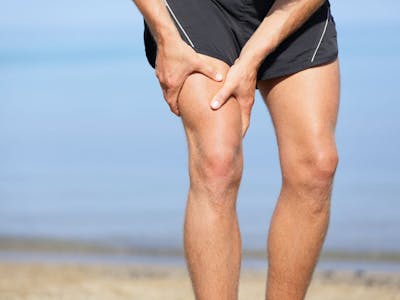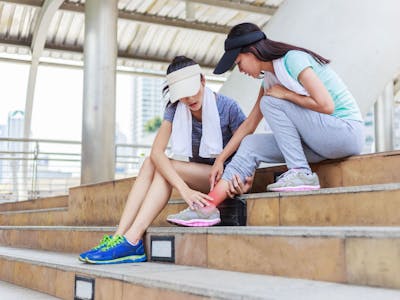-
Muscle Strains
A strain is the partial or complete tearing of muscle fibers. Muscle fibers are the individual units that make up your muscles. Muscle strains can be caused by strong or repeated contractions. Muscle strains are categorized as mild (grade I), moderate (grade II) and severe (grade III).
- A grade I strain is a mild disruption of the muscle fibers. There may be mild swelling and tenderness. It may also be painful to stretch and use the injured muscle.
- A grade II strain indicates moderate muscle fiber damage. The pain is moderate to severe, it definitely hurts to use and stretch the injured muscle, and ecchymosis may be present. Ecchymosis (commonly called bruising) indicates that there was internal damage to blood vessels that resulted in bleeding within and around the muscle. This bleeding is often visible under the skin as purple, blue, red, yellow, and even green in color.
- A grade III strain is the most severe. It is the complete tearing of a muscle into two pieces, or separation of the muscle from its associated tendon. There is severe pain, complete loss of muscle strength, swelling is normally present with ecchymosis, and there may be a palpable "indentation" where the muscle is torn. Medical intervention is usually necessary. Typically, an orthopaedist (musculoskeletal specialist) will evaluate your condition and surgical repair may be necessary.
Treatment for Strains
Directly after a strain, control the swelling with PRICE for 24 to 48 hours:
- Protect the area from further injury by using a sling for an arm or shoulder injury or crutches for a leg or foot injury.
- Rest the injured joint/extremity.
- Ice for 20 minutes every hour.
- Compress with an elastic Ace bandage or brace for an ankle or knee, a splint for an injured finger or buddy-taping for an injured toe.
- Elevate above the heart, if possible.
An over-the-counter acetaminophen, such as Tylenol® or non-steroidal anti-inflammatory drug (NSAID), such as Advil® may help with reducing the swelling and pain/ pressure relief. After this home treatment, be sure to have the injury evaluated by your doctor to rule out a fracture or a severe strain.
Most mild strains heal with a few days to a week. Seeing a physical therapist can also help you regain range of motion. Your physical therapist can also show you injury prevention techniques to help prevent future strains.
If your symptoms don't improve within a couple of days, or you experience any of the following, see your doctor to have it immediately evaluated:
- An audible "popping" sound with the injury
- Pain and swelling that gets worse over time
- Fever or chills
- Difficulty standing or walking without pain
- Limited flexibility and range of movement around the injured joint
- Numbness or tingling
- Joint/extremity deformity or signs of instability
Moderate strains may require bracing for a period of time, followed by physical therapy to help regain normal function and range of motion. Severe strains may require surgery to repair the tear, followed by physical therapy to rehabilitate the injury.
-
Ligament Sprains
A sprain is an overstretching or tearing of one or more ligaments. Ligaments are crisscross bands of fibrous tissue that connect bones together and stabilize joints. Sprains are usually caused by a joint being suddenly forced beyond its normal range of motion and the ligaments are overstretched or torn. Joint sprains commonly occur at the knee, ankle and acromioclavical joint in the shoulder.
Sprains are classified as mild (grade I), moderate (grade II) and severe (grade III).
- Grade 1 (mild): slight over-stretching and a little damage to the ligament fibers.
- Grade 2 (moderate): partial tearing of the ligament with abnormal looseness (laxity) in the joint when moved in certain ways.
- Grade 3 (severe): Complete ligament tear, which causes severe instability and makes the joint nonfunctional.
Symptoms
Common symptoms of sprains include
- Bruising around the injured joint
- Pain around the injured joint
- Edema (swelling)
- Limited flexibility and range of motion due to pain
Treatment for Sprains
Treatment of sprains directly after they occur are the same as that for strains, controlling the swelling with PRICE for 24 to 48 hours:
- Protect the area from further injury by using a sling for an arm or shoulder injury or crutches for a leg or foot injury.
- Rest the injured joint/extremity.
- Ice for 20 minutes every hour.
- Compress with an elastic Ace bandage or brace for an ankle or knee, a splint for an injured finger or buddy-taping for an injured toe.
- Elevate above the heart, if possible.
An over-the-counter acetaminophen, such as Tylenol® or non-steroidal anti-inflammatory drug (NSAID), such as Advil® may help with reducing the swelling and pain/ pressure relief. After this home treatment, be sure to have the injury evaluated by your doctor to rule out a fracture or a severe sprain or strain.
Most mild strains heal within about 10 days. Once the swelling goes down and your sprain is feeling better, we can help you regain your range of motion and show you injury prevention techniques to help prevent future strains.
If your symptoms don't improve within a couple of days, or you experience any of the following, see your doctor to have it immediately evaluated:
- An audible "popping" sound with the injury
- Pain and swelling that gets worse over time
- Fever or chills
- Difficulty standing or walking without pain
- Limited flexibility and range of movement around the injured joint
- Numbness or tingling
- Joint/extremity deformity or signs of instability
Moderate sprains may require bracing for a period of time, followed by physical therapy to help regain normal function and range of motion. Severe sprains may require surgery to repair the tear, followed by physical therapy to rehabilitate the injury.


